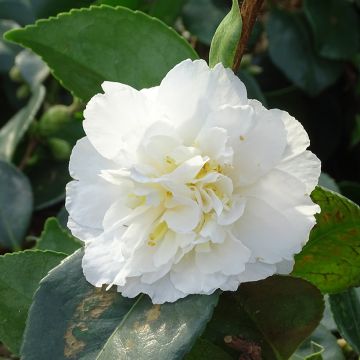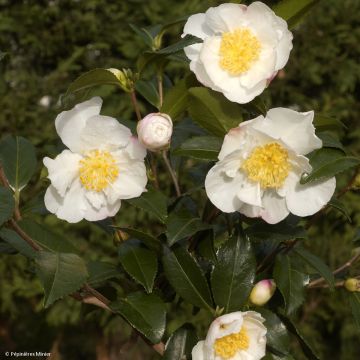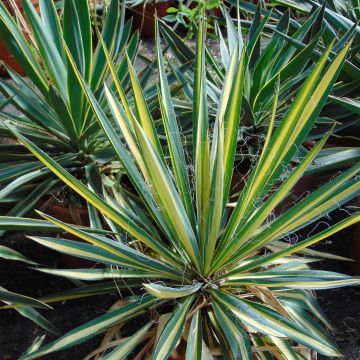

Camellia Yuletide


Camellia Yuletide


Camellia Yuletide


Camellia Yuletide


Camellia Yuletide


Camellia Yuletide
Camellia Yuletide
Camellia sasanqua x vernalis Yuletide
Autumn Camellia, Christmas Camellia
Very good plant received intact and well packaged. The foliage was vigorous and a healthy green. The plant is now magnificent and full of flowers.
LaurentD, 04/12/2025
Special offer!
Receive a €20 voucher for any order over €90 (excluding delivery costs, credit notes, and plastic-free options)!
1- Add your favorite plants to your cart.
2- Once you have reached €90, confirm your order (you can even choose the delivery date!).
3- As soon as your order is shipped, you will receive an email containing your voucher code, valid for 3 months (90 days).
Your voucher is unique and can only be used once, for any order with a minimum value of €20, excluding delivery costs.
Can be combined with other current offers, non-divisible and non-refundable.
Home or relay delivery (depending on size and destination)
Schedule delivery date,
and select date in basket
This plant carries a 24 months recovery warranty
More information
We guarantee the quality of our plants for a full growing cycle, and will replace at our expense any plant that fails to recover under normal climatic and planting conditions.

Would this plant suit my garden?
Set up your Plantfit profile →
Description
Camellia 'Yutelide' is an autumn camellia variety that bears deep, intense vermillion red flowers, a rare colour for this type of camellia. They are not very large, with a simple shape, but truly shine against a dark and glossy foliage, bringing a lot of joy to the garden or terrace during the short days of autumn and winter. This bush also charms with its naturally dense, compact, and pyramidal habit, giving it a very modern appearance. It should be planted in a partially shaded position, in a limestone-free soil that remains moist during summer.
The 'Yutelide' camellia, introduced in the U.S.A in 1959, is a hybrid of the species Camellia sasanqua and C. vernalis, belonging to the family of Theaceae. 'Yutelide' forms a densely growing shrub with an erect and bushy habit, growing quite slowly, reaching approximately 1.5 m (5 ft) in height and 1 m (3 ft) in width after 15 years. Flowering begins in November and ends in January-February. The flowers, measuring 7.5 cm (3 in) in diameter, are composed of 5 to 7 spatula-shaped petals of a bright red colour slightly tending towards orange. These petals are regularly arranged in a flat cup around a heart filled with numerous golden stamens. While they are not long-lasting, these brilliant-textured flowers continuously renew themselves on the plant, forming a carpet of petals on the ground just as Japanese cherry trees do. The foliage is dense and evergreen all year round. The small leaves are elliptical-ovate, 4.5 cm (2 in) long and 2.5 cm (1 in) wide, very dark green, shiny, leathery, and paler on the underside.
Camellia x sasanqua 'Yutelide' performs better in mild and humid climates than in cold regions, where its hardiness is sometimes lacking and its flowering compromised. Wherever the winter is not too harsh it can be planted alone in the garden or combined with other acid-loving plants (Rhododendron, azaleas, Hydrangea, Pieris) to form a small flowering hedge. Japanese maples also bring lightness to camellias. The 'Yutelide' camellia, with its naturally compact shape and exceptional flowering, deserves a prominent location on the terrace, near the entrance of the house, or alongside a pathway. You can surround its base with autumn bulbs such as colchicums or cyclamen. In colder regions, it is best to place it on a balcony or terrace to be brought into a veranda or cold greenhouse for protection during the flowering period. If necessary it can be protected from the cold inside the house, provided its foliage is regularly misted and it is watered with non-calcereous water.
Report an error about the product description
Camellia Yuletide in pictures






Plant habit
Flowering
Foliage
Botanical data
Camellia
sasanqua x vernalis
Yuletide
Theaceae
Autumn Camellia, Christmas Camellia
Cultivar or hybrid
Other Autumn Camellia
View all →Planting and care
'Yutelide' Camellia should be placed in a fairly shaded area, sheltered from cold and drying winds. It can be grown in a sunny (but not scorching) site as long as the roots remain cool. Plant it in a fresh, humus-rich, acidic, and well-drained soil. Do not plant the bush too deeply; the top of the root ball should be covered with 3 cm (1.2 in) of soil. In winter cover it with a 5 to 7 cm (2 to 3 in) thick mulch composed of leaf compost and crushed bark. Beware of late frosts that can damage the flowers and buds. Water during dry periods to prevent the bush dropping its flower buds. It is recommended to plant camellias in autumn to promote good root development and better flowering from the first year. Possible diseases include chlorosis caused by excess limestone, brown spots caused by burns on leaves exposed to full south, sooty mould, scale insects, and weevils.
Planting period
Intended location
Care
-
, onOrder confirmed
Reply from on Promesse de fleurs
Similar products
Haven't found what you were looking for?
Hardiness is the lowest winter temperature a plant can endure without suffering serious damage or even dying. However, hardiness is affected by location (a sheltered area, such as a patio), protection (winter cover) and soil type (hardiness is improved by well-drained soil).

Photo Sharing Terms & Conditions
In order to encourage gardeners to interact and share their experiences, Promesse de fleurs offers various media enabling content to be uploaded onto its Site - in particular via the ‘Photo sharing’ module.
The User agrees to refrain from:
- Posting any content that is illegal, prejudicial, insulting, racist, inciteful to hatred, revisionist, contrary to public decency, that infringes on privacy or on the privacy rights of third parties, in particular the publicity rights of persons and goods, intellectual property rights, or the right to privacy.
- Submitting content on behalf of a third party;
- Impersonate the identity of a third party and/or publish any personal information about a third party;
In general, the User undertakes to refrain from any unethical behaviour.
All Content (in particular text, comments, files, images, photos, videos, creative works, etc.), which may be subject to property or intellectual property rights, image or other private rights, shall remain the property of the User, subject to the limited rights granted by the terms of the licence granted by Promesse de fleurs as stated below. Users are at liberty to publish or not to publish such Content on the Site, notably via the ‘Photo Sharing’ facility, and accept that this Content shall be made public and freely accessible, notably on the Internet.
Users further acknowledge, undertake to have ,and guarantee that they hold all necessary rights and permissions to publish such material on the Site, in particular with regard to the legislation in force pertaining to any privacy, property, intellectual property, image, or contractual rights, or rights of any other nature. By publishing such Content on the Site, Users acknowledge accepting full liability as publishers of the Content within the meaning of the law, and grant Promesse de fleurs, free of charge, an inclusive, worldwide licence for the said Content for the entire duration of its publication, including all reproduction, representation, up/downloading, displaying, performing, transmission, and storage rights.
Users also grant permission for their name to be linked to the Content and accept that this link may not always be made available.
By engaging in posting material, Users consent to their Content becoming automatically accessible on the Internet, in particular on other sites and/or blogs and/or web pages of the Promesse de fleurs site, including in particular social pages and the Promesse de fleurs catalogue.
Users may secure the removal of entrusted content free of charge by issuing a simple request via our contact form.
The flowering period indicated on our website applies to countries and regions located in USDA zone 8 (France, the United Kingdom, Ireland, the Netherlands, etc.)
It will vary according to where you live:
- In zones 9 to 10 (Italy, Spain, Greece, etc.), flowering will occur about 2 to 4 weeks earlier.
- In zones 6 to 7 (Germany, Poland, Slovenia, and lower mountainous regions), flowering will be delayed by 2 to 3 weeks.
- In zone 5 (Central Europe, Scandinavia), blooming will be delayed by 3 to 5 weeks.
In temperate climates, pruning of spring-flowering shrubs (forsythia, spireas, etc.) should be done just after flowering.
Pruning of summer-flowering shrubs (Indian Lilac, Perovskia, etc.) can be done in winter or spring.
In cold regions as well as with frost-sensitive plants, avoid pruning too early when severe frosts may still occur.
The planting period indicated on our website applies to countries and regions located in USDA zone 8 (France, United Kingdom, Ireland, Netherlands).
It will vary according to where you live:
- In Mediterranean zones (Marseille, Madrid, Milan, etc.), autumn and winter are the best planting periods.
- In continental zones (Strasbourg, Munich, Vienna, etc.), delay planting by 2 to 3 weeks in spring and bring it forward by 2 to 4 weeks in autumn.
- In mountainous regions (the Alps, Pyrenees, Carpathians, etc.), it is best to plant in late spring (May-June) or late summer (August-September).
The harvesting period indicated on our website applies to countries and regions in USDA zone 8 (France, England, Ireland, the Netherlands).
In colder areas (Scandinavia, Poland, Austria...) fruit and vegetable harvests are likely to be delayed by 3-4 weeks.
In warmer areas (Italy, Spain, Greece, etc.), harvesting will probably take place earlier, depending on weather conditions.
The sowing periods indicated on our website apply to countries and regions within USDA Zone 8 (France, UK, Ireland, Netherlands).
In colder areas (Scandinavia, Poland, Austria...), delay any outdoor sowing by 3-4 weeks, or sow under glass.
In warmer climes (Italy, Spain, Greece, etc.), bring outdoor sowing forward by a few weeks.


















































